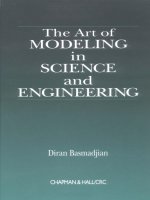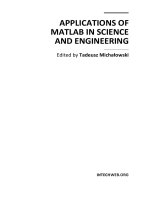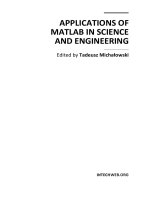MATHEMATICAL METHOD IN SCIENCE AND ENGINEERING Episode 10 pps
Bạn đang xem bản rút gọn của tài liệu. Xem và tải ngay bản đầy đủ của tài liệu tại đây (2.5 MB, 40 trang )
MAPPINGS
313
Fig.
12.12
Conformal mapping
12.4.1
Conformal Mappings
To
see
an interesting property
of
analytic functions we differentiate
w
=
f
(
12.115)
at
zo,
where the modulus and the arguments. of the derivative
are
given
as
I
$
I
and
a,
respectively. We now use polar coordinates to write the modulus
20
lim
At-0
and the argument (Fig. 12.12)
as
a
=
lim arg[Azu]
-
lim arg[Az]
Az-0
Ar-0
(12.116)
(
12.1 17)
(12.118)
(12.119)
Since this function,
f
(z)
,
maps
a
curve
c,
in the z-plane into another curve
c,
in the w-plane, from the arguments
[&.
(12.119)] it is seen that if the
slope of
c,
at is
00,
then the slope of
cw
at
wo
is
a+&.
For
a
pair
of
curves
intersecting at
a
the angle between their tangents in the
w-
and z-planes will
be
equal, that is,
4'2
-
41
=
(02
+
a)
-
(0,
+
a),
(
12.120)
=
e2
-el.
(12.121)
Hence analytic functions preserve angles between the curves they map (Fig.
12.12).
For
this reason they are also called conformal mappings or transfor-
mations.
314
COMPLEX VARIABLES AND FUNCTIONS
fig.
12.13
Two
plates
with
hyperbolic
cross
sections
12.4.2
Electrostatics and
Conformal
Mappings
Conformal mappings are very useful in electrostatic and laminar (irrotational)
flow problems, where the Laplace equation must
be
solved.
Even though the
method is restricted
to
cases
with one translational symmetry,
it
allows one
to solve analytically some complex boundary value problems.
Example
12.10.
Conformal mappings and electrostatics:
Let
us
con-
sider two conductors held
at
potentials
Vi
and
V2
with hyperbolic cross
sections
x2
-
9’
=
c1
and
x2
-
y2
=
c2.
(12.122)
We want to find the equipotentials and the electric field lines. In the
complex z-plane the problem can be shown
as
in Figure 12.13. We use
the conformal mapping
(12.123)
=x2-$+2(2Xy)
(
12.124)
2
W=Z
to
map these hyperbolae
to
the straight lines
u
=
c1
and
u
=
c2
(12.125)
in the w-plane (Fig. 12.14). The problem is now reduced to finding
the equipotentials and the electric field lines between two infinitely long
MAPPINGS
315
fig.
12.14
Equipotentials
and
electric
field
lines in
the
w-plane
parallel plates held at potentials
Vl
and
.V2,
where the electric field lines
are given by the family
of
lines
2,
=
c3
(12.126)
and the equipotentials are given by the lines perpendicular to these as
u
=
ci.
(12.127)
Because the problem is in the z-plane, we make the inverse transforma-
tion to obtain the electric field lines
as
(v
=)
2zy
=
cj
(12.128)
and the equipotentials
as
(u
=)
z2
-
y2
=
cz.
(12.129)
In three dimensions, to find the equipotential surfaces these curves must
be extended along the direction
of
the normal to the plane of the paper.
Example
12.11.
Electrostatics and conformal mappings:
We now find
the equipotentials and the electric field lines inside two conductors with
semicircular cross sections separated by an insulator and held at poten-
tials
+V,
and
-V&
respectively (Fig.
12.15).
The equation
of
a circle
316
COMPLEX VARIABLES AND FUNCTIONS
+
z-plane
Fig.
12.15
Two
conductors
with
semicircular
cross
sections
in the z-plane
is
given
as
22+y2=
1.
We use the conformal mapping
w
(2)
=
In
(-)
l+z
1-2
'
(12.130)
(12.131)
to map these semicircles into straight lines in the w-plane
(Fig.
12.16).
Using Equation
(12.131)
we write
(12.132)
l+z+iy
1-2-zy
u
+
iu
=
In
1
1
-
22
-
y2
+
2iy
1
-22+22+y2
=In[
and express the argument of the In function
as
Reia:
u+zv=InR+icu.
Now the
u
function is found
as
U=Ly
2Y
1
-
(22fy2)'
=
tan-'
(12.133)
(12.134)
(12.135)
MAPPINGS
317
4
U
v
=
-d2
6
Fig.
12.16
Two
semicircular conductors
in
the
w-plane
From the limits
and
(12.136)
we
see
that the two semicircles in the z-plane are mapped to two straight
lines given as
Equipotential surfaces in the w-plane cam now be written easily
as
av,,
V(v)
=
?I.
7r
(12.139)
Using Equation
(12.135)
we transform this into the z-plane to find the
equipotentials
as
- -
R
(12.140)
(I
2.14 1)
Because this problem has translational symmetry perpendicular to the
plane
of
the paper, equipotential surfaces in three dimensions can be
318
COMPLEX VARIABLES AND FUNCTIONS
found by extending these curves in that direction. The solution
to
this
problem has been found rather easily and in closed form. Compare this
with the separation
of
variables method, where the solution is given
in terms
of
the Legendre polynomials
as
an infinite series. However,
applications
of
conformal mapping are limited to problems with one
translational symmetry, where the problem can
be
reduced to two di-
mensions. Even though there are tables of conformal mappings, it is not
always easy
as
in this
case
to find an analytic expression for the needed
mapping.
12.4.3
For laminar (irrotational) and frictionless
flow,
conservation of mass is given
as
Fluid Mechanics and Conformal Mappings
g
+
7.
(p-i')
=
0,
(12.142)
where
p(?",)
and
-i'(?",t)
represent the density and the velocity
of
a
fluid
element.
For
stationary flow we write
aP
-
=
0,
at
(12.143)
thus Equation (12.142) becomes
3.
(p-i')
=
0.
(12.144)
Also,
a
lot
of
realistic situations can
be
approximated by the incompressible
fluid equation of state, that is,
p
=
const. (12.145)
This further reduces Equation (12.144) to
V.3=O0.
(12.146)
This equation alone is not sufficient to determine the velocity field
*(?",t).
If
the flow is irrotational, it will also satisfy
?XT=O,
(12.147)
thus the two equations
V-3=0
(12.148)
and
Vx-i'=O
(12.149)
MAPPINGS
319
Fig.
12.17
Flow
around
a
wall
of
height
h
completely specify the kinematics
of
laminar, frictionless flow of incompress-
ible fluids. These equations are also the expressions
of
linear and angular
momentum conservations for the fluid elements. Fluid elements in laminar
flow follow streamlines, where the velocity
g(?",t)
at
a
given point is tan-
gent to the streamline at that point.
Equations (12.148) and (12.149) are the sarme
as
Maxwell's equations in
electrostatics. Following the definition
of
electrostatic potential, we use Equa-
tion (12.149) to define
a
velocity potential as
(12.150)
++
21
(T
,t)
=
Tkq7,t).
Substituting this into Equation (12.148) we obtain the Laplace equation
V2@(7,
t)
=
0.
(12.151)
We should note that even though
a(?",
t)
is
known
as
the velocity potential
it is very different from the electrostatic potential.
Example
12.12.
Flow around an obstacle
of
height h:
Let us consider
laminar flow around an infinitely long and thin obstacle
of
height
h.
Since
the problem has translational symmetry, we can show it in two dimen-
sions as in Figure 12.17, where we search for
a
solution
of
the Laplace
equation in the region
R.
Even though the velocity potential satisfies the Laplace equation like
the electrostatic potential, we have to
be
careful with the boundary
conditions. In electrostatics, electric field lines are perpendicular to the
equipotentials; hence the test particles can only move perpendicular to
the conducting surfaces. In the laminar flow case, motion perpendicular
320
COMPLEX VARIABLES AND FUNCTIONS
to
the surfaces is not allowed because fluid elements follow the contours
of the bounding surfaces. For points
far
away from the obstacle,
we
take
the flow lines
as
parallel
to
the z-axis.
As
we approach the obstacle, the
flow lines follow the contours of the surface.
For
points away from the
obstacle, we set
v,
=
1.
(12.152)
We now look for
a
transformation that maps the region
R
in the z-plane
to the upper half
of
the w-plane. Naturally, the lower boundary
of
the
region
R
in Figure 12.17 will be mapped to the real axis of the w-plane.
We now construct this transformation in three steps: We first use
w1=
z
2
(12.153)
to map the region
R
to the entire wl-plane. Here the obstacle
is
between
0
and -h2.
As
our
second step, we translate the obstacle to the interval
between
0
and
h2
by
~2
=
z2
+
h2.
(12.154)
Finally we map the w2-plane to the upper half of the w-plane by
w
=
6.
(12.155)
The complete transformation from the z-plane to the w-plane can be
written
as
(Fig. 12.18)
w
=
JW.
The Laplace equation can now be easily solved in the upper half
of
the
w-plane, and the streamlines are obtained
as
21
=
cj.
Curves perpendicular to these will give the velocity equipotentials
as
U=
bj.
Finally transforming back to the z-plane we find the streamlines
as
the
curves
cj
=
Irn[J2TP],
and the velocity
of
the fluid elements that are tangents to the streamlines
(Fig. 12.19) are given
as
MAPPINGS
321
wz=
w
,
+
h2
I
fig.
12.18
Transition
from
the z-plane
to
the w-plane
322
COMPLEX VARIABLES AND FUNCTIONS
h
T’
4
z-plane
fig.
12.20
upper half
of
the w-plane
Schwara-Christoffel transformation maps the inside of a polygon to
the
12.4.4
Schwarz-Christoffel Transformations
We have seen that analytic transformations are also conformal mappings,
which preserve angles. We now introduce the Schwarz-Christoffel transfor-
mations, where the transformation is not analytic at an isolated number of
points. Schwarz-Christoffel transformations map the inside
of
a polygon in
the z-plane to the upper half of the w-plane (Fig.
12.20).
To
construct the
Schwarz-Christoffel transformations let
us
consider the function
(12.156)
MAPPINGS
323
where
A
is complex,
kl
is real, and w1
is
a
point on the u-axis. Comparing
the arguments of both sides in Equation (12.156) we get
arg
(2)
=
lim [arg Az
-
arg
Awl
Aw-0
lim [arg
Az
-
arg Awl
=
Aw40
w
>Wl
As
we move along the positive u-axis
lim arg Aw
=
arg
[dw]
=
0,
Aw-0
hence we can write
lim [arg
Az]
=
arg[dz]
=
Aw40
w
>
w1
(12.157)
(12.158)
(12.159)
For
a
constant
A
this means that the transforwation [Eq. (l2.156)] maps the
parts of the u-axis; w
<
w1 and w
>
w1, to two line segments meeting
at
zo
in the z-plane. Thus
A
(w
-
WI)-~' (12.160)
corresponds to one
of
the vertices of
a
polygon with the exterior angle
kl~
and located at
z1.
For
a
polygon with n-vert.ices we can write the Schwarz-
Christoffel transformation as
dz
-
=
A
(W
-
~1)~~'
(W
-
w2)-IC2
.
(w
-
w,)-~"
.
dw
(12.161)
Because the exterior angles
of
a
polygon add
up
to
21r,
powers
ki
should satisfy
the condition
c
ki
=
2.
(12.162)
i=l
Integrating Equation (12.161) we get
z
=
A/w
(w
-
w~)-~'
(w
-
WZ)-~'
.
(w
-
w,)-ICn
dw
+
B,
where
B
is
a
complex integration constant.
In1
this equation
A
determines the
direction and
B
determines the location
of
the polygon in the z-plane. In
a
Schwarz-Christoffel transformation there are all together 2n
+
4
parameters,
that
is,
n wis, n
kis,
and
4
parameters from the complex constants
A
and
B.
A
polygon can
be
specified by giving the coordinates
of
its n vertices in the
z-plane. Along with the constraint [Eq. (12.162)] this determines the 2nfl
of
the parameters in the transformation. This means that we have the freedom
to
choose the locations
of
the three
wi
on the
real
axis
of
the w-plane.
324
COMPLEX
VARIABLES
AND
FUNCTIONS
fig.
12.21 Region
we
map in
Example
(12.13)
Example
12.13.
Schwarz-ChristofSel transformation:
We now construct
a
Schwarz-Christoffel transformation that maps the region shown in
Fig-
ure 12.21 to the upper half of the w-plane. Such transformations are
frequently needed in applications.
To
construct the Schwarz-Christoffel
transformation we define
a
polygon whose inside, in the limit
as
z3
+
-00,
goes
to the
desired
region (Fig. 12.22). Using the freedom in
defining the Schwarz-Christoffel transformation we map the points
z1
,
22,
and
z3
to the points
w3 + 00, w1=-1, w2=+1 (12.163)
in the w-plane. We now write the Schwarz-Christoffel transformation
as
(12.164)
Powers
lcl,
lcg,
and
lc3
are
determined from the figure
as
f,
f,
and
1,
respectively. Note how the signs of
lc;
are chosen
as
plus because of the
counterclockwise directions shown in Figure 12.22. Because the constant
c
is still arbitrary, we define
a
new finite complex number A
as
C
-+
A,
lim
___
( W3)k3
W3-'-00
so
that the SchwarzrChristoffel transformation becomes
dz
-
=A(w+l)-f(w-l)-f,
dw
(12.165)
(12.166)
(12.167)
MAPPINGS
325
fig.
12.22
the
limit
z3
-+
00
The
polygon
whose interior goes
to
the desired region in Example
12.13
in
This
can be integrated
as
z
=
A
cosh-'
w
+
B,
(12.168)
where the constants
A
and
B
are found from the locations
of
the vertices,
that is.
as
Example
12.1.
d
A=-
and
B=id
T
(12.169)
(12.170)
(12.171)
Semi-infinite parallel plate capacitor:
V
-
now calcu-
late the fringe effects in
a
semi-infinite parallel plate capacitor. Making
use of the symmetry
of
the problem we can concentrate on the region
shown in Figure 12.23.
To
find
a
Schwarz-Christoffel transformation
that maps this region into the upper half
of
the w-plane we choose the
points on the
real
w-axis
as
1
I
z4
-+
w4+
+a
z1
-+
w1 +
-m
(12.172)
326
COMPLEX VARIABLES AND FUNCTIONS
,
z-plane
Fig.
12.23
Semi-infinite parallel plate capacitor
Since
kz
=
-1
and
Ic3
=
1,
we can write
d.z
dw
-
=
c(w
+
i)pk2
(w
-
-
(w
+
1)
-
c-
W
1
=
c(l+
).
Integrating this we get
z
=
c(w
+
Inw)
+
D.
If
we substitute
20
=
lwl
eib,
Equation (12.174) becomes
z
=
c
[1w[
ei+
+In
lzul+24]
+
D.
Considering the limit in Figure 12.24 we can write
z,PPer
-
zpwer
- -
zd.
.
Using Equation (12.176) this becomes
upper
-
$wer
=
[O
+
i
(4;pper
-
&wer)]
23
=
Ci(n-O),
(12.173)
(12.174)
(12.175)
(
12.176)
(12.177)
MAPPINGS
327
fig.
12.24
Limit
of
the
point
z3
thus determining the constant
c
as
d
c=
(12.178)
n-
On the other hand, considering that the vertex
22
=
id
(12.179)
is
mapped to the point
-1
in the w-plane, we
write
d
id
=
-
(-1
+i~)
+
D
(
1
2.1
80)
lr
and determine
D
as
d
D= (12.181)
n-
This determines the Schwarz-Christoffel transformation
d
z=
-[w+Inui+I],
7r
(12.182)
which maps the region shown in Figure 12.23 to the upper half w-plane
shown in Figure 12.25. We now consider the transformation
d
(12.183)
z
=
-
In w
or
w
=
ezx/d,
which maps the region in Figure 12.25 to the region shown in Figure
12.26 in the %plane. In the 2-plane equipotentials
are
easily written
as
jj
=
const.
=
-d
or
V
(jj)
=
3g.
(12.184)
-
lr
V
VO
d
Using the inverse transformation in Equation (12.182), we write
z=x+zy
(12.185)
328
COMPLEX VARIABLES AND FUNCTIONS
fig.
12.25
w-Plane
for
the semi-infinite parallel plate capacitor
Fig.
12.26
Z-Plane
for
the semi-infinite parallel plate capacitor
PROBLEMS
329
This
gives
us
the parametric expression
of
the equipotentials in the
z-
plane (Fig. 12.27)
as
sin
(:T)
+
qd.
V
y=
?re
(12.186)
(12.187)
Similarly, the electric field lines in the ?-plane are written
as
Z
=
const. (12.188)
Transforming back to the z-plane, with the definitions
fig.
12.27
Equipotentials
for
the semi-infinite parallel plate capacitor
-
(12.189)
33
YX
-=K
and
Q=-
d
d'
we get
d
d
x=-
[e"
cos6
+
I.]
+
K ,
7r
7r
(12.190)
(12.191)
d
y=
-[e"sinQ+8].
T
330
COMPLEX
VARIABLES AND FUNCTIONS
Problems
12.1
equation
For
conjugate harmonic pairs show that if
q
(u,u)
satisfies the Laplace
82*(u,
u)
a2qu,
u)
aU2
+
au2
=O
in the w-plane, then
q
(2,
y)
will satisfy
in the z-plane.
12.2
Show that
u(2,
y)
=
sin
z
cosh
y
+
x2
-
y2
+
4xy
is a harmonic function and find its conjugate.
12.3
Show that
u(z,
y)
=
sin 2z/(cosh
2y
+
cos
2z)
can be the real part of an analytic function
f(z).
Find its imaginary part and
express
f(
z)
explicitly as a function of
z.
12.4
Using cylindrical coordinates and the method of separation of variables
find the equipotentials and the electric field lines inside two conductors with
semi-circular cross sections separated by an insulator and held at potentials
+VO
and
-VO,
respectively (Fig.
12.15).
Compare your result with Example
12.11
and show that the two methods agree.
12.5
With aid of a computer program plot the equipotentials and the elec-
tric field lines found in Example
12.14
for the semi-infinite parallel plate
ca-
paci t or.
12.6
In a two-dimensional potential problem the surface
ABCD
is at poten-
tial
VO
and the surface
EFG
is at potential zero. Find the transformation (in
differential form) that maps the region
R
into the upper half of the w-plane
(Fig.
12.28).
Do
not integrate but determine all the constants.
12.7
Given the following twc+dimensional potential problem in Figure
12.29,
The surface ABC is held at potential
VO
and the surface
DEF
is
at
potential
zero. Find the transformation that maps the region
R
into upper half
of
the
w-plane.
Do
not integrate but determine all the constants in the differential
form of the transformation
12.8
Find the Riemann surface on which
J(z
-
1)(z
-
2)(z
-
3)
PROBLEMS
331
4
2-
plane
Fig.
12.28
Two-dimensional equipotential problem
-m
-mt
E
V=O
F
X
Fig.
12.29
Schwartz-Christoffel !.ransformation
8.
Find the Riemann surface on which
d(z
-
l)(z
-
2)(
z
-
3)
is
single valued and analytic except at
z
:=
1,2,3.
9.
Find the singularities
of
f(
z)
=
tanh
L.
10.
Show that the transformation
332
COMPLEX VARIABLES AND FUNCTIONS
t
v=o
fig.
12.30
Rectangular
region
surrounded
by
metallic
plates
or
maps the
21
=const. lines into circles in the z-plane.
12.11
Use the transformation given in Problem 12.10 to find the equipoten-
tials and the electric field lines for the electrostatics problem
of
two infinite
parallel cylindrical conductors, each
of
radius
R
and separated by a distance
of
d,
and held at potentials
+VO
and
-Vo,
respectively.
12.12
Consider the electrostatics problem for the rectangular region
sur-
rounded by metallic plates
as
shown in Figure 12.30. The top plate
is
held
at potential
VO,
while the bottom and the right sides are grounded
(V
=
0).
The two plates are separated by an insulator. Find the equipotentials and the
electric field lines and plot.
12.13
in the limit
as
Map the real w-axis into the triangular region shown in Figure 12.31,
25
f
03
and
23
f
-03
12.14
Find the equipotentials and the electric field lines for a conducting
circular cylinder held
at
potential
VO
and parallel
to
a
grounded infinite con-
ducting plane (Fig. 12.32). Hint: Use the transformation
z
=
a
tanhiw/2.
PROBLEMS
333
- -
fig.
12.31
%angular region
fig.
12.32
Conducting circular cylinder parallel to infinite metallic plate
This Page Intentionally Left Blank
13
COMPLEX
INTEGRALS
and
SERIES
In this chapter we
first
introduce the complex integral theorems. Using ana-
lytic continuation we discuss how these theorenis can
be
used
to
evaluate some
frequently encountered definite integrals. In conjunction with our discussion
of definite integrals, we also introduce the gamma and beta functions. We
also introduce complex series and discuss classification of singular points.
13.1
COMPLEX INTEGRAL THEOREMS
I.
Cauchy-Goursat Theorem
Let
C
be
a
closed contour in
a
simply connected domain (Fig.
13.1).
If
a
given function,
f
(z),
is analytic in and on this contour, then the integral
is true.
Proof.
We
write the function
f
(2)
as
f
(2)
=
'11
+
217.
(13.2)
335
336
COMPLEX INTEGRALS AND SERIES
f”
n
Fig.
13.1
Contour
for
the
Cauchy-Goursat
theorem
Integral
(13.1)
becomes
(u
+
iv)
(dz
+
idy)
=
f
(udx
-
vdy)
+
i
(vdx
+
udy)
.
(13.3)
f
Using the Stokes theorem
we can write integral
(13.3)
as
(u
+
iv)
(dz
+
idy)
=
SS,
(-&
-
”>
ds
+
SJ,
(2
-
$)
ds,
da:
dY
(13.5)
where
5’
is an oriented surface bounded by the closed path
C.
Because
the Cauchy-Riemann conditions are satisfied in and on the
closed
path
C,
the right-hand side
of
Equation
(13.5)
is zero, thus proving the the-
orem.
11.
Cauchy
Integral
Theorem
If
f
(z)
is analytic in and on a closed path
C
in a simply connected domain
13.2)
and
if
~0
is a point inside the path
C,
then we can write the
(Fig.
integral
(13.6)
COMPLEX
IN
JEGRAL THEOREMS
337
Fig.
13.2
Contour
for
the Cauchy integral theorem
Proof.
To prove this theorem we modify th'e path in Figure
13.2
and use
that in Figure
3.3,
where we can use the Cauchy-Goursat theorem to
write
(13.7)
This integral must be evaluated in the liniit
as
the radius of the path
Co
goes
to
zero. Integrals over
L1
and
L2
cancel each other. Also noting
that the integral over
Co
is taken clockwise, we write
(13.8)
where both integrals are now taken counterclockwise. The integral on
the left-hand side is what we want. For the integral on the right-hand
side we can write
Using the substitution
z
-
hand side can
be
evaluated easily, giving
us
=
beie,
the first integral on the right-
The second integral in Equation
(13.9),
which we call
I,,
can
be
bounded









